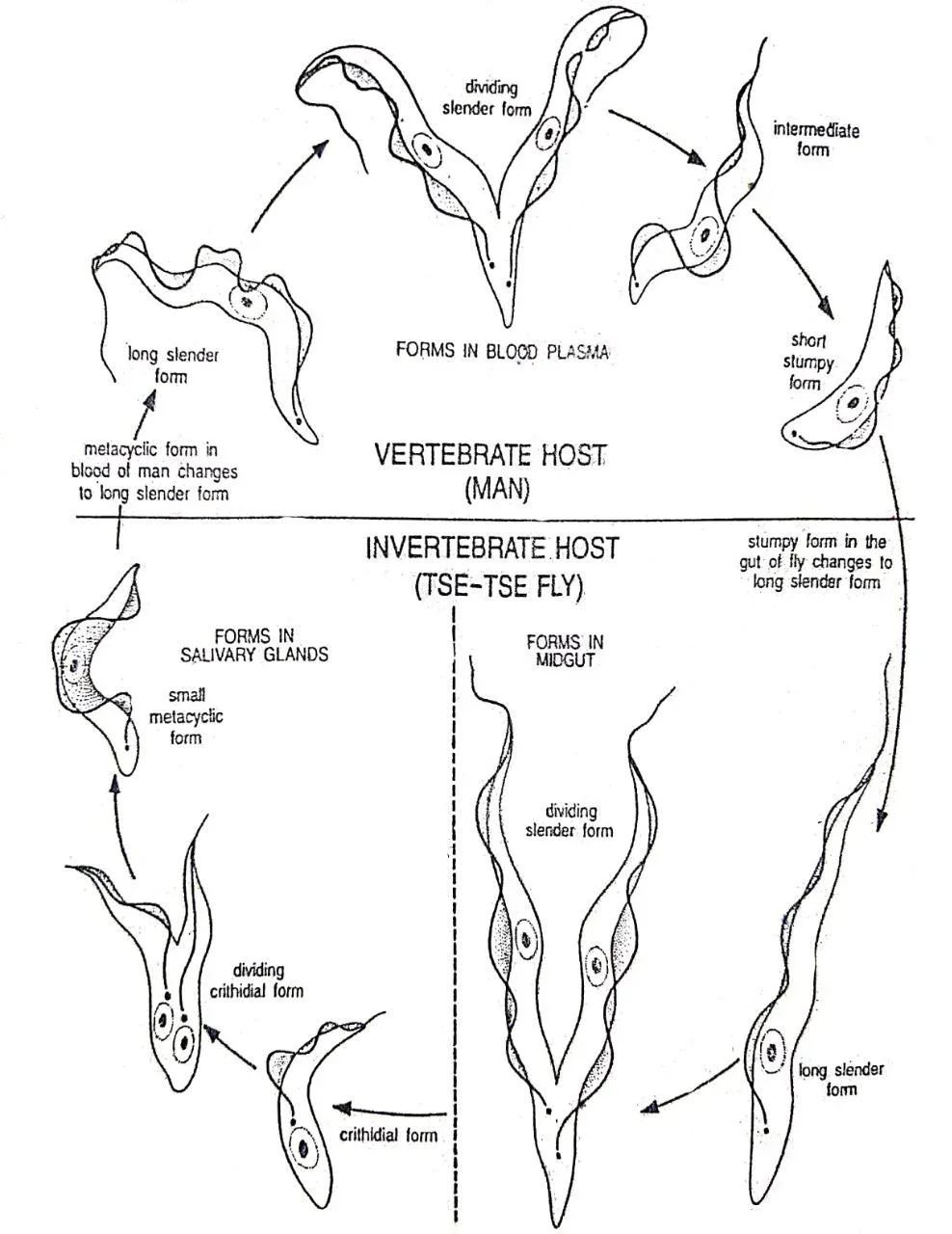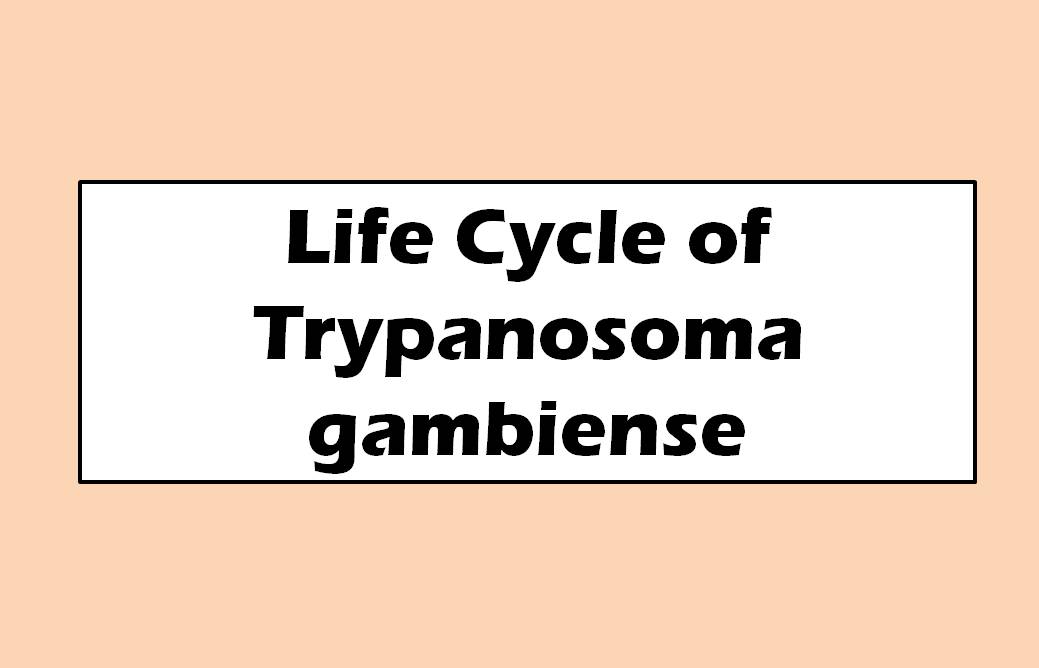Trypanosoma gambiense is a species of parasite that causes African trypanosomiasis, also known as sleeping sickness. The life cycle of Trypanosoma gambiense involves two distinct developmental stages: one is found in the bloodstream of man and the another stage is found inside the blood-sucking tsetse fly. In this article, we will learn the life cycle of Trypanosoma gambiense.
Hosts

- Trypanosoma gambiense is a digenetic parasite which means it completes its life cycle in two hosts.
- Man is the primary or principal or definitive host because, in the bloodstream of man, the parasite attains its sexual maturity.
- The tsetse fly(Glossina palpalis) is the intermediate host or vector of the parasite because the fly transmits the parasite from one individual of the principal host to another.
- Some mammals like antelopes, pigs, buffaloes, etc. often act as reservoir hosts because the parasite often utilizes them as a temporary refuge until the appropriate principal host is found.
Life Cycle in Man
1. Infection
-
-
- The infection to man by the parasite is always initiated by the tsetse fly.
- The infective metacyclic forms of the parasite Trypanosoma gambiense reside inside the lumen of the salivary glands of the tsetse flies.
- When the fly bites a man to suck blood, it releases infective trypanosomes into his bloodstream.
- To suck blood, the fly first punctures the skin surface of a man. Then the fly uses its saliva to prevent blood clotting. Thus the infective trypanosomes enter the bloodstream of man.
-
2. Multiplication
-
-
- The parasites are extracellular as they are present in the blood plasma, not inside the cells.
- The metacyclic forms of the trypanosomes are devoid of flagella. After the infection, they transformed into long slender forms with flagella.
- With the beating of the free flagellum, trypanosomes swim freely in the blood.
- In this stage, they multiply actively by longitudinal binary fission.
- The multiplying trypanosomes obtain energy by anaerobic glycolysis.
-
3. Metamorphosis
-
-
- When glycolysis is hampered due to the antibodies, the trypanosomes stop multiplying.
- Then they shrink to short stumpy forms having no free flagellum.
- During the transformation from long slender forms to short stumpy forms, the intermediated forms also appear.
- These intermediate forms and short stumpy forms depend on their energy supply upon the aerobic oxidation of pyruvic acid.
- The short stumpy forms do not feed and ultimately die, if they are not sucked up by the tsetse flies.
-
4. Relapse of Infection
-
-
- Some of the long and slender trypanosomes do not undergo transformation, but change the antigens of blood to which the host has produced antibodies.
- These slender forms survive and continue to multiply in the blood leading to future relapses of the infection.
-
Life Cycle in The Tsetse Fly
1. Transfer to Tsetse Fly
-
-
- The tsetse flies suck the blood of an infected person and take the short stumpy forms of the trypanosomes.
- The trypanosomes continue development inside the fly.
-
2. Development in Mid-gut
-
-
- Further development occurs inside the mid-gut of the tsetse fly.
- Here the trypanosomes transform into long and slender forms.
- Then they multiply by means of longitudinal binary fission.
-
3. Development in Salivary Glands
-
-
- The long and slender forms of the trypanosomes come to the salivary glands through oesophagus and mouthparts.
- Here they metamorphose into crithidial forms.
- The crithidial forms have shortened body, reduced free flagellum, and the kinetoplast in front of the nucleus.
- The mitochondrion develops an extensive network of cristae.
- The crithidial forms multiply in the lumen of the salivary glands.
- Then the crithidial forms transform into slender metacyclic forms.
- This metacyclic form enters into the blood stream of man when the tsetse fly bites a healthy man.
-
Frequently Asked Questions
Ques 1: Where Trypanosoma gambiense lives in human body?
Ans 1: It lives in the blood plasma of human.
Ques 2: What is the host of Trypanosoma gambiense?
Ans 2: Man is the primary host and Tsetse fly is intermediate host.
Ques 3: What is the infective stage of Trypanosoma gambiense?
Ans 3: The infective metacyclic forms of the Trypanosoma gambiense is the infective stage.
Ques 4: What type of pathogen is Trypanosoma gambiense?
Ans 4: It is a parasitic protozoan.
Ques 5: Is Trypanosoma gambiense unicellular or multicellular?
Ans 5: It is a unicellular parasitic protozoan.
————-THE END———-
Read More:
- Morphology of Trypanosoma gambiense | Diagram
- African Sleeping Sickness or Trypanosomiasis: Symptoms, Diagnosis, Treatment, and Prevention
- General Characters of All Phylum of The Invertebrates.
Reference:
- “Modern Textbook of Zoology Invertebrates” written by R. L. Kotpal.

